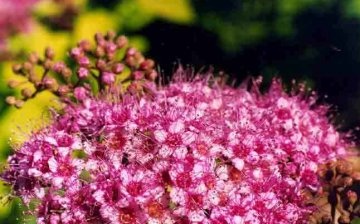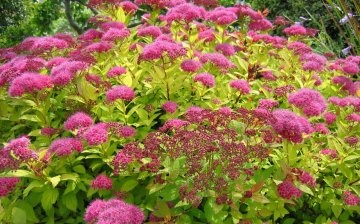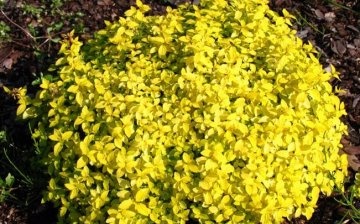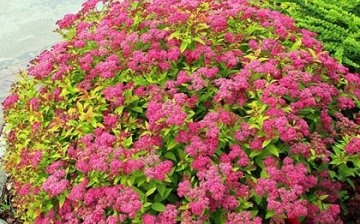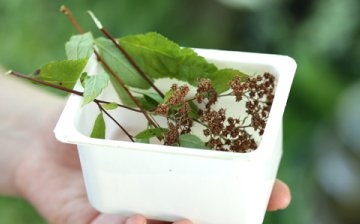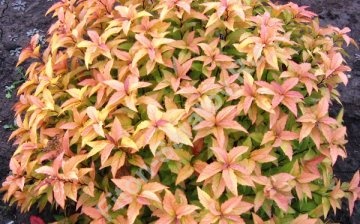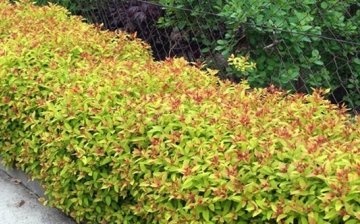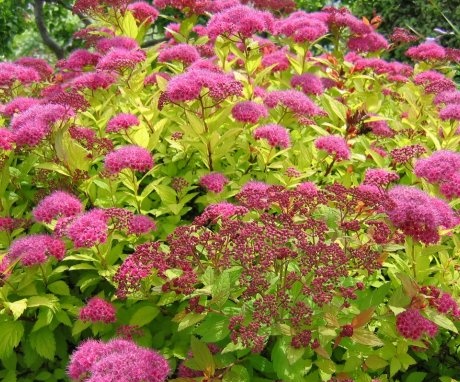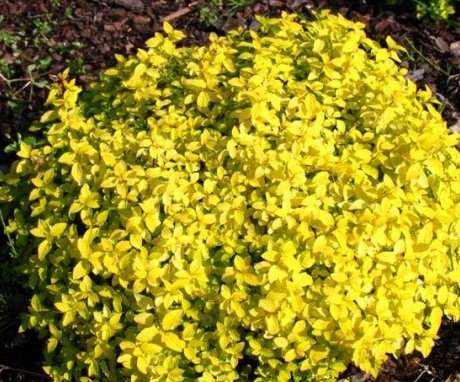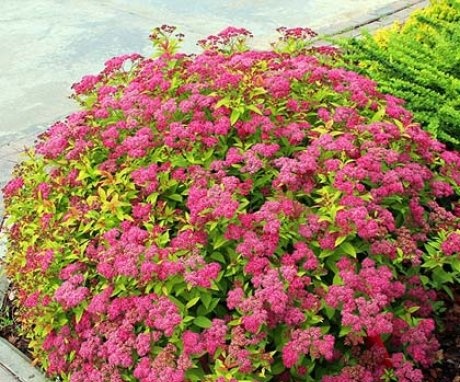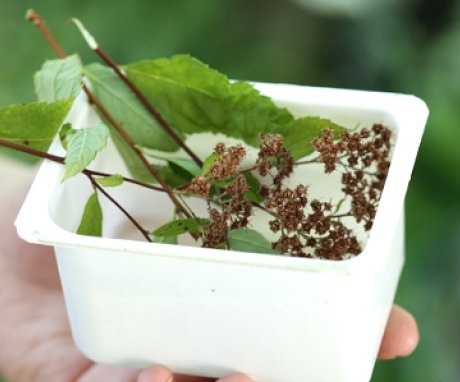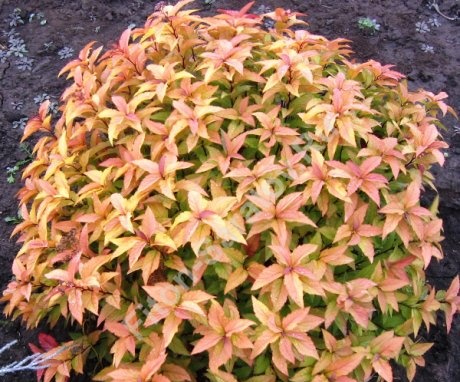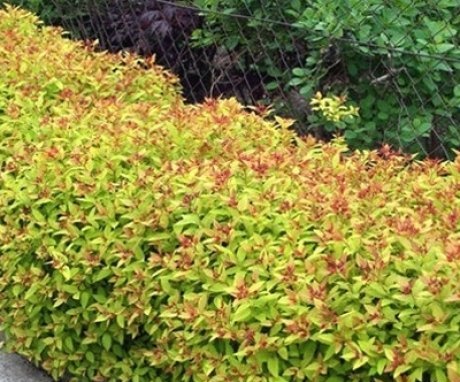Spirea Gold Flame - we grow a beautiful ornamental shrub in our garden
Shrubs spireas have great decorative value. Its bushes have interesting curved branches, thanks to which the plant got its name. "Spirea" is translated from Greek as bend.
Content:
- General information about the plant
- Spirea varieties
- Spirea care Gold Flame
- Reproduction methods
- Shrub pruning
- Shrub application
General information about the plant
Spirea - perennial deciduous shrub that belongs to the Rosaceae family. The shape and size of the plant depends on the variety, as does the flowering period, color of the flower and the shape and size of the foliage.
The height of the shrubs varies from 70 cm to
2 meters. The branches can form a round, creeping, cascading and pyramidal shrub. Some varieties of spirea begin to bloom in early May, others in mid-summer. Therefore, by combining plants, you can get a blooming garden for almost the entire season. The buds form umbellate inflorescences at the ends of the shoots.
Spirea varieties
Spring varieties:
- Spiraea is oak-leaved. It's big and tall bush, the height of which can reach 2 meters. Stems are branching, drooping. Flowering begins in mid-May. Leaves are medium in size, ovoid, pointed at the end and serrated. They are painted in bright green and green tones. Veins are light green, pronounced. The buds are small, located in an umbellate inflorescence, the petals are white, the stamens are long and hang from the middle of the flowers. During flowering, the bush is covered with white blossoming inflorescences, falling from branches to the ground, popularly called this variety "bride".
- Spirea Arguta. The Arguta bush has strong, up to 2 meters long, sticking out in different directions and slightly drooping branches. Leaves are medium in size, densely arranged on the stems. Narrow, oblong leaves are painted in a dark green tone. The flowers are small, painted in a white tone, during flowering they completely cover the entire perimeter of the stems, so that no leaves or branches are visible.
- Spirea nippon. A small shrub, the height of which reaches only 100 cm. Branching stems form a spherical shape. With some pruning techniques, the shape of the bush can be changed to creeping. The leaves are small, green, not densely covering the stems. It blooms with white small inflorescences that are abundantly formed on the branches of the plant.
Summer varieties:
- Spirea Gold Flame. This is a small bush, the height of which can reach 80 cm. Its branches grow in width, forming a circle with a diameter of 100 cm. The variety has a special decorative effect due to its leaves. The shape of the nickname is oval, oblong, with notches. The color of the leaves changes depending on the period from a reddish-orange tone to yellow. During the flowering period, the leaves are bright green in color. The buds are formed in summer, in July, abundant flowering begins, which lasts until mid-autumn. The flowers are small in size, collected in corymbose inflorescences, the petals are painted in a pink tone.
- White-flowered spirea. This is a short bush up to 60 cm in height. Stems are strong, branching. The leaves are medium in size, not densely located on the stems, painted in a bright green tone.The buds are collected in inflorescences, the flowers are small, the petals are white. A distinctive feature of the variety is that when flowering, the plant exudes a pleasant aroma. The rest of the summer-flowering varieties are odorless.
- Spirey Bumald. It is a hybrid variety that forms a bush of 120 cm in height. The leaves are alternately located on the stems, have an oblong oval shape, pointed at the ends and slightly concave in the middle along the main central vein. Inflorescences are formed at the ends of the shoots. The flowers are small, colored in pink. The variety does not tolerate long and frosty winters, therefore it needs good insulation.
- Spirea willow. This variety is tall. The branching stems of the bush stretch out more than 2 meters in height. The shoots are strong and straight. Medium-sized leaves resemble willow leaves, elongated, oblong and pointed at the ends. Their color changes from green to red depending on the season. Flowers are collected in long inflorescences that form at the ends of the shoots. The flowers are small, have 5 petals, painted in a light pink tone, and stick out long stamens.
Spirea care Gold Flame
For spirea, it is recommended to choose a well-lit place for landing... The plant is not demanding on soils, but fertile, loose soils with good drainage are best suited so that the water does not stagnate.
Watering spireas:
- Water the plant sparingly, but regularly, especially during dry and hot periods.
- After each watering, the soil must be loosened, this is especially important for young bushes.
- Loosening allows air to penetrate to the roots and is also removed weeds.
- After watering, the land under the bush can be mulch peat or compost for longer moisture retention.
Every year, organic and mineral fertilizers... Top dressing is carried out 3-4 times a season. Moreover, after fertilization, the bushes are well watered. Such a regime will preserve the health of the bush and a beautiful appearance.
Plants are planted in the spring or autumn, depending on the flowering time of the variety.
It is recommended to prepare the soil before planting seedlings. To do this, you need to dig a depression, the size of which should be 25% larger than the root system of the plant. Mix the soil with peat, river sand, turf and leafy soil. The depth of the pit should be at least 50 cm. Drainage is laid out on the bottom, a part of the prepared earth is poured on top. The seedling is positioned so that when buried, the root collar remains at ground level.
Spirea bushes are planted at a distance of 40 cm, when planting for hedges, and at a distance of 80-100 cm when landing in landscape design compositions. Almost all varieties of spirea are frost-resistant and do not need additional shelter. But if young bushes are planted, and winter is predicted to be frosty, it is recommended to insulate the roots and young shoots with sawdust, thick paper or foliage.
Reproduction methods
All types of spirea reproduce using seedexcept for hybrid varieties. Also plants can be propagated cuttings and layering.
When propagating with seeds, you must:
- Pre-prepare a container where young plants will grow. For this, a wide box may be suitable, which is filled with loose fertile soil.
- You can prepare the land yourself by mixing turf, peat, compost and river sand in equal proportions.
- Sowing is recommended in early spring.
- After that, the soil is moistened, mulched, and the container is transferred to a warm, well-lit room for seed germination.
After 1-1.5 weeks, the first shoots begin to appear. They must be regularly watered with soft water at room temperature using a spray bottle. 2.5-3 months after the seeds sprouted seedlings you can dive into the ground.This process is carried out in the evening or cloudy weather, so that young roots can adapt to new soil without strong sunlight.
When picking it is necessary to slightly prune the main root on each seedling, this stimulates the regrowth and branching of young roots.
The seedlings must be regularly looked after by weeding weeds and watering the bushes. The flowering of such bushes begins only after 4 years, after planting them in open ground.
When propagating using cuttings, you must:
- Prepare the material in advance. To do this, from semi-lignified healthy and strong branches that have formed in the current year, segments are cut, 10-12 cm long.
- Before planting for rooting, it is recommended process cuttings with stimulating solutions.
- Further, the branches must be buried in the prepared soil and watered regularly.
- When planted in mid-summer, a good root system is formed by autumn.
Spirea bushes can also be propagated using layering, while all the signs of the mother bush are preserved, and flowering begins the next year after planting.
Spirea propagation by layering:
- To get a good young bush, it is necessary to bend the extreme branches along the perimeter to the ground and fix it in a small depression without separating it from the main bush.
- Cover the hole with earth, and keep the attachment point constantly wet.
- This process is carried out in the spring. The next year, rooted young plants can be separated from the mother bush and transplant to a new place for permanent growth.
- During rooting, all emerging buds and inflorescences must be removed so that all the power goes to the development of the bush.
Shrub pruning
For varieties whose flowering period begins in spring, pruning carried out immediately after flowering. At the same time, diseased and dry branches, as well as branches that have already passed 5 years old, are removed. This will give the young stems room to grow and develop.
It is impossible to shorten healthy faded branches, as the violent growth of lateral shoots will begin, on which small and unsightly inflorescences are formed.
You can also disturb the beautiful and natural shape of the bush. Pruning for other varieties is carried out in early spring. It should start on bushes that have already reached the age of 4 years. This is done in order to maintain the correct shape of the bush. When pruning, old, diseased and dry branches are removed.
Shrub application
Spirea is often used by designers in landscaping gardens and areas near the house. An unpretentious plant with dense branches and abundant color looks good as hedges. They are also planted in separate bushes and the craftsmen cut them in various bizarre and simple forms.
One of the benefits of this plant is its long flowering period.
Some types of spirea are planted in areas near apiaries, since the flowers of the plant are a good honey plant. Many varieties are used for medicinal purposes, as the foliage and flowers contain a large amount of various vitamins and minerals.
Spirea is an unpretentious plant and every amateur gardener can plant such beauty on his plot... It goes well with all plants.
More information can be found in the video.



